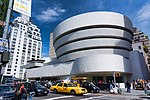Church of the Heavenly Rest
1865 establishments in New York (state)20th-century Episcopal church buildingsChurches completed in 1929Churches in ManhattanEpiscopal church buildings in New York City ... and 6 more
Fifth AvenueGothic Revival church buildings in New York CityNRHPweekly errorsProperties of religious function on the National Register of Historic Places in ManhattanReligious organizations established in 1865Upper East Side

The Church of the Heavenly Rest is an Episcopal church located on the corner of Fifth Avenue and 90th Street, opposite Central Park and the Carnegie Mansion, on the Upper East Side of New York City. The church is noted for the architecture of its building, location on Museum Mile, Outreach, Thrift, Music and Arts programs, and for some of its congregation members.
Excerpt from the Wikipedia article Church of the Heavenly Rest (License: CC BY-SA 3.0, Authors, Images).Church of the Heavenly Rest
East 90th Street, New York Manhattan
Geographical coordinates (GPS) Address External links Nearby Places Show on map
Geographical coordinates (GPS)
| Latitude | Longitude |
|---|---|
| N 40.7837 ° | E -73.958 ° |
Address
Church of the Heavenly Rest
East 90th Street
10128 New York, Manhattan
New York, United States
Open on Google Maps









